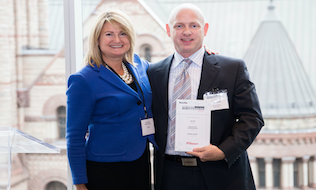

For Manulife, building its benefits plan communication strategy was all about choice. Recognizing there are different ways employees prefer to access information, it rolled out a strategy that ensured a number of different communications options were available.
This strategy helped Manulife earn the benefits plan communications award at Benefits Canada’s 2017 Workplace Benefits Awards in Toronto on Oct. 12.
“We have five generations in the workforce today, and their needs are different depending on where they are in their lives, their careers and even their goals and aspirations,” says Maria Fraga, assistant vice-president and head of global benefits and wellness at Manulife. “We recognize that a one-size-fits-all approach no longer works, we needed to provide flexibility and choice for employees to elect the benefits package that fits their needs.”
Read: 65% of employers see benefits communications as a high priority
When Manulife launched its new flexible benefits plan in January 2017, its first communications were traditional media, such as posters and hard-copy mailings distributed to employees so they could bring them home to discuss decisions with their family members.
As well, the organization sent out an email and a document of frequently asked questions to all managers to prepare them in advance for any inquiries their employees might have. Subsequently, an email went out to all employees introducing the program. It included a video featuring senior leadership, showcased a new microsite designed for use on a variety of platforms and called on employees to prepare for enrolment in the new program. Manulife also sent out letters to employees on leave so they could enrol in the new program.
The average open rate of the five emails notifying employees of enrolment was 80 per cent. The company also saw more than 160,000 hits on the microsite during the enrolment period.
The microsite features two interactive tools to guide members through the process of selecting their benefits. Its learning tool provides employees with a video personality to engage with, using a question-and-answer format to determine information like marital status, benefits requirements, need for security and other concerns. And its decision tool further coaches employees through decisions by making suggestions based on how they answered the questions, helping them to create their optimal scenarios within the program.
Read: Tips for boosting employee acceptance of benefits changes
“A lot of work went into understanding what employees want and building a program that meets their individual needs, and we understand that communications is a key, critical part of that,” says Fraga. “After all, you can offer the best benefits but if you don’t communicate it well, it doesn’t matter.”
Employees made significant use of the tools: 35 per cent of employees used the interactive learning feature and 44 per cent used the decision tool. Among employees who answered a subsequent survey about the tools, 93 per cent said they found them helpful and two out of five said they used them more than once.
All in, almost 91 per cent of employees have now actively enrolled in the program.
Read: Using benefits design to drive employee engagement
A major aim of using such a diverse set of media to reach employees was to ensure employees’ family members could also get involved in the decision-making around benefits, says Fraga. “A key component of our strategy was also to communicate to not only our employees at work but also to communicate to the home, so that the spouse [and] family understood the new program and had the information necessary to make informed decisions about the benefits that best fit the family needs.”
A full list of the 2017 Workplace Benefits Awards’ winners is available here.
Do you have a great story to tell about your organization’s health or pension programs? Enter the 2018 Workplace Benefits Awards. The deadline for submissions is June 30, 2018.
